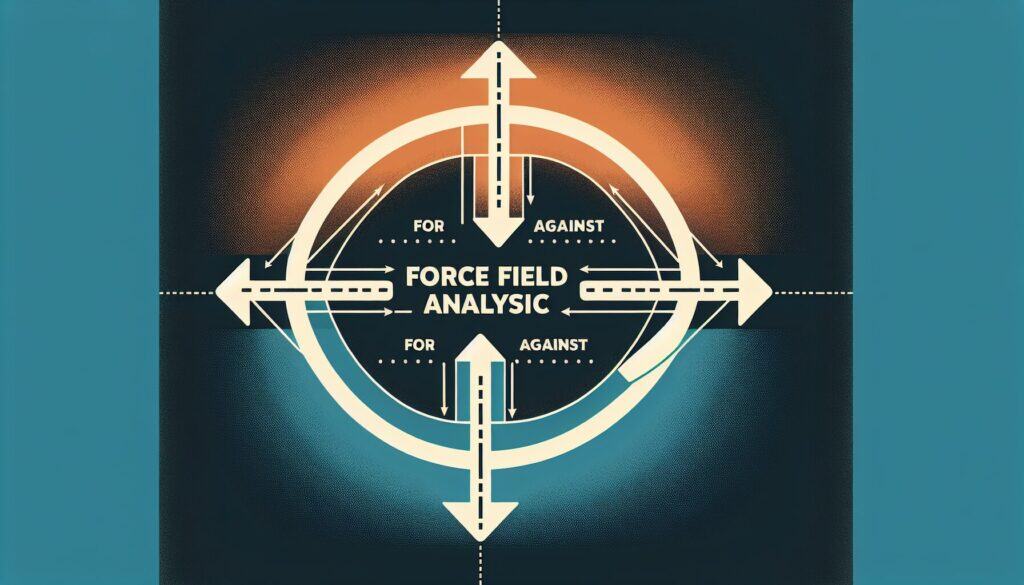To analyze the forces for and against a proposed change.
- المنهجيات: الهندسة, الجودة
تحليل مجال القوة

تحليل مجال القوة
- إدارة التغيير, التحسين المستمر, تحسين العمليات, إدارة المشاريع, إدارة الجودة, إدارة المخاطر, تحليل SWOT, العمل الجماعي
الهدف:
كيفية استخدامه:
- A decision-making tool that involves identifying driving forces (factors supporting the change) and restraining forces (factors opposing the change). Each force is typically assigned a score, and the analysis helps in strategizing how to strengthen driving forces and weaken restraining forces.
الايجابيات
- Provides a clear visual summary of factors influencing a change; Helps in understanding the complexities of a change initiative; Facilitates discussion and consensus building; Aids in developing strategies to manage change effectively.
سلبيات
- Can be subjective in identifying and scoring forces; May oversimplify complex situations; Does not provide a definitive solution, only a framework for analysis; The process of quantifying qualitative forces can be challenging.
الفئات:
- الموارد البشرية, حل المشكلات, إدارة المشاريع
الأفضل لـ
- Making decisions about a proposed change by systematically identifying and evaluating the factors that will support or hinder it.
Force Field Analysis is widely applied across various sectors such as healthcare, education, manufacturing, and software development during the planning and implementation phases of projects that involve change initiatives. This methodology is typically initiated by project managers, change agents, or team leaders who seek to drive significant modifications, like the introduction of new technologies or reforms in organizational policies. It is valuable during the early stages of projects when understanding stakeholder perceptions is essential for success or when conducting impact assessments related to potential changes. Participants in these discussions often include cross-functional teams comprising engineers, designers, business analysts, and end-users, ensuring diverse perspectives are represented. By quantifying driving and restraining forces, teams can visualize the balance of power influencing the change process, which aids in facilitating open dialogue for consensus-building. For example, in an engineering context, Force Field Analysis may be employed during the design phase of a new product to weigh the benefits of cutting-edge materials against potential production challenges, enabling more informed decision-making. Furthermore, it supports strategic planning by allowing organizations to formulate actionable steps to bolster supportive factors while mitigating resistance, thus increasing the likelihood of successful implementation within a structured إدارة التغيير framework.
الخطوات الرئيسية لهذه المنهجية
- Clearly define the change initiative or decision to be analyzed.
- Identify and list all driving forces supporting the change.
- Identify and list all restraining forces opposing the change.
- Assign scores to each driving and restraining force according to their impact.
- Create a visual representation of the driving and restraining forces.
- Analyze the balance of forces to understand potential outcomes.
- Develop strategies to strengthen driving forces and mitigate restraining forces.
- Implement the strategies and monitor the effects on driving and restraining forces.
نصائح للمحترفين
- Incorporate stakeholder feedback throughout the Force Field Analysis process to refine the understanding of driving and restraining forces.
- Use a scoring system that quantifies the strength of each force, enabling data-driven discussions about prioritization and strategy development.
- Regularly revisit and update the Force Field Analysis to adapt to changing internal and external factors that may influence the change initiative.
لقراءة عدة منهجيات ومقارنتها, نوصي باستخدام
> مستودع المنهجيات الشامل <
مع أكثر من 400 منهجية أخرى.
نرحب بتعليقاتكم على هذه المنهجية أو المعلومات الإضافية على قسم التعليقات أدناه ↓، وكذلك أي أفكار أو روابط متعلقة بالهندسة.
السياق التاريخي
1902
1907
1915
1915-11
1918
1920
1922
1902
1904
1913
1915
1916
1919-05-29
1920
1924
(إذا كان التاريخ غير معروف أو غير ذي صلة، على سبيل المثال "ميكانيكا الموائع"، يتم تقديم تقدير تقريبي لظهوره الملحوظ)















منشورات ذات صلة
حاسبة METS إلى السعرات الحرارية
التحليل التلوي
تخطيط الرسائل
مخططات النموذج الذهني
الحد الأقصى لقوى الدفع والسحب المقبولة
تخطيط الاحتياجات المادية (MRP)